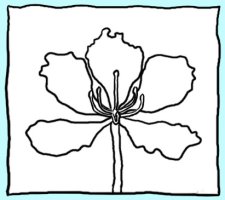Text types: Text formats for presenting information
| Charts & diagrams |
Using charts and diagrams
Charts and diagrams represent information in a visual way instead of using words (although charts and diagrams can also include words). Even with young children it is possible to use simple diagrams to help them with their reading and writing.
We often use diagrams when we want to simplify something. A photograph, for example might be lifelike, but it might be too detailed for our purposes. A diagram could be used instead to focus only on the important features of an object:
|
|

|
Diagrams such as this are very useful for language teaching. Teachers can quickly draw them on the board to stimulate discussion or to explain a point.
As well as lifelike diagrams, we find more abstract diagrams such as symbols:

One way of grouping diagrams is in terms of whether they represent a sequence or a concept.
Sequence diagrams
We can use diagrams to represent various types of sequences:
| timeline | |
| storyline | |
| steps in a procedure | |
| explanation | |
| argument |
Concept diagrams
We use concept diagrams to describe how something looks or is organised in a spatial sense:
| description | |
| part-whole | |
| 'types of ...' | |
| compare / contrast |
These types of diagrams can be useful in teaching the various text types.
For PrimeTeach teaching activities involving charts and diagrams see:
![]() Finding
out about fire engines
Finding
out about fire engines
![]() Furniture
and home
Furniture
and home
![]() The
sun and the planets
The
sun and the planets
|
Tell me more ... Timelines |
|
||
To give us feedback about this section, click here or on the Comment button at the top of the screen.
If you have any questions about this section, visit the Language Corner.
If you have any questions or suggestions about how to teach this section, send a message to the Teaching Corner.